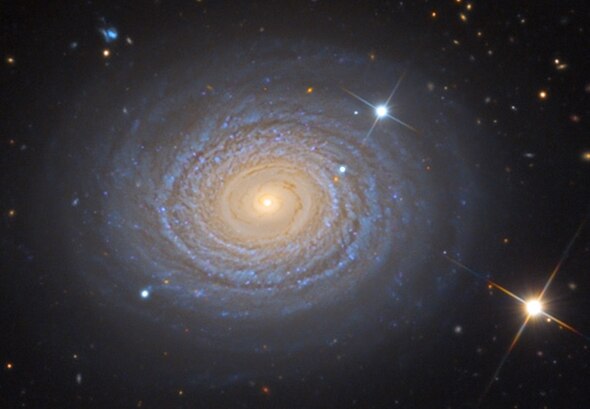Create a free profile to get unlimited access to exclusive videos, sweepstakes, and more!
The Glory of Spirals

Because why not, here are two glorious spiral galaxies to brighten your week.
The first image is by my friend Adam Block, and it shows NGC 488, a tightly wound spiral about 100 million light-years away. I love how delicate it looks; the blue arms are well-separated but fluffy; I’d almost call this a flocculent spiral.
The inner region is very interesting; it’s much redder, which generally indicates the presence of older stars—blue stars are very massive and don’t live long, exploding as supernovae after only a few million years or so. That leaves longer-lived redder stars behind, so where you see big red regions you’re usually seeing a place where stars haven’t been born in a long time.
It’s interesting that you can still see a spiral pattern in the red inner region and a clear set of dust lanes as well. Thick dust is dark, blocking light behind it. Thinner dust, though, can scatter away blue light (like the Earth’s air does to sunlight, making the sky blue). I wonder if there’s just a lot of dust spread around that inner region of the galaxy, reddening it. A quick literature search didn’t turn up anything, though.
Either way, I strongly urge you to check out Adam’s larger and higher-resolution image of this object. It’s stunning, with bright stars and scattered background galaxies, with some of the latter many hundreds of millions or even over a billion light-years away. It’s gorgeous.
Speaking of gorgeous, the second image is of M 94, a much closer spiral at about 16 million light-years distant. Hubble observed it, showing just the inner region, producing this spectacular image:
That ring of blue stars is real; M 94 seems to be producing a lot of young stars in a circular region around the nucleus. The size of the ring indicates it may be due to a resonance phenomenon, forcing gas clouds and stars orbiting the galaxy at that distance closer together. It’s a bit like pumping your legs in time with swinging on a swing, forcing your arc to go higher; in this case it has to do with the gravity of the rotating galaxy as a whole “pumping” the orbits of objects within it. Anyway, it causes gas clouds to collide, collapse, and form stars.
That becomes a little more obvious in another shot of M94 from Hubble … well, actually the same shot, but this time including colors that highlight the presence of those gas clouds:
Astrophotographer Robert Gendler put this shot together, and he included some data from the Subaru Telescope as well. The pinkish-red is emitted by the gas clouds, and the blue color of the young, massive, and very hot stars is a lot more obvious.
Man, I do so love splashy spiral galaxies. The science and physics involved in their structure is both powerful and sublime, and their beauty … well, that’s tough to match.
Want to learn more about spiral galaxies? Then do I have a Crash Course Astronomy episode for you!


























